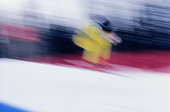
WEDNESDAY, Dec. 30 (HealthDay News) — Skiing can be thrilling, but hurtling down a snowy mountain can also be risky, experts say.
Many skiers have learned the hard way just how easily a fracture, tear or sprain can ruin a trip, and the chances of getting hurt aren’t based solely on fate or luck, said Dr. Scott Hacker, a team physician for the U.S. Ski Association and Olympic Ski Team and an orthopedic surgeon at Alvarado Hospital in San Diego.
Skiers can take precautions to make sure they end their day sipping hot chocolate in the lodge and not waiting to see an orthopedist in the emergency room.
- Before you go, get in shape: If you haven’t done much skiing recently, or exercise for that matter, work on strengthening your core and improving your lower-body flexibility. Suggested exercises include hip stretches to prevent muscle tears and the wall sit to strengthen the quadriceps. Pilates and yoga help build abdominal core strength, Hacker said. Some gyms also offer ski-conditioning programs.
- Check your equipment: Have a professional inspect your ski equipment and make sure it fits you well and suits your skill level. Don’t forget your helmet, which can protect from devastating head injuries.
- Ski to your ability: To put it simply, stay away from black diamonds if you’re a novice, even if all of your friends are headed for the more challenging runs. Skiing the slopes that match your ability level is much safer, Hacker said.
- Ski to conditions: The quality of the snow and weather can make skiing more or less challenging. Fractures, for example, are more common on hard-pack snow days, while ligament injuries and muscle tears usually occur when the snow is soft and powdery. “The difficulty of a run can change dramatically in a couple of hours due to steepness, lighting and snow,” Hacker said. “Just because it is rated at a certain level, it may not be right for you.” Use your own judgment in addition to the ski resort’s guidelines.
- Watch your form: Keeping both shoulders facing downhill and pivoting from the waist down can help minimize risk of injury. Novices can learn proper form by taking a ski class, though even more advanced skiers can pick up valuable tips from ski instructors.
- Look out for that tree: Pay attention to your surroundings and stay vigilant about watching for hazards, including fellow skiers, snowmaking equipment and ice patches, rocks and crevasses.
- Give yourself time to adjust to the altitude: Symptoms of altitude sickness can include sleep disturbances, headache, dizziness, fatigue and shortness of breath with exertion. Dehydration also occurs more rapidly at higher elevations, so drink plenty of water. If you’re not feeling your best, take it easy your first day or so on the slopes to give your body time to adjust. Always avoid alcohol while skiing.
- Wear sunscreen: The snow is a powerful reflector of UV rays, so protect your skin and your eyes with sunglasses or goggles, even when it’s cloudy.
- Never ski alone and call it quits when you’re tired: Many an injury has occurred at the end of the day, when skiers are fatigued, form and mental alertness begins to slip, and the sun begins to set. If you’re having second thoughts about that last run, go with your gut and call it a day, Hacker advised.
More information
The American Academy of Orthopaedic Surgeons has more on preventing ski injuries.

